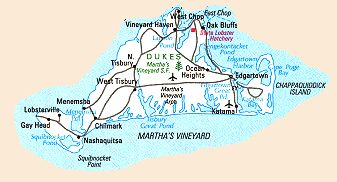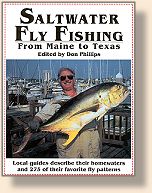Martha's Vineyard lies along the southern coast of Massachusetts and Cape
Cod. The Vineyard is a large island, some 20 miles long as the crow flies
from the tip of Cape Poge on the eastern end of Chappaquidick to the cliffs
of Gay Head on the western tip, and almost 10 miles wide. The Island is
large enough to have distinct regions, the most populated being "down island"
where the towns on Vineyard Haven, Oak Bluffs, and Edgartown lie in close
proximity. It is here that the majority of inns, hotels and restaurants are located
and offer every type of accommodation to suit all tastes. All three towns are
distinctly different experiences; from the stately wealth of Edgartown to the
freewheeling nightlife in Oak Bluffs. The Vineyard is accessable by ferry or
air. The ferry runs regularly from Woods Hole in Falmouth, Massachusetts
for both cars and walk-on passengers. Walking on is easy. Bringing a car
across requires advanced reservations.
 From the map, it is easy to see why Martha's Vineyard is such a magnificent
fishery. The island is riddled with estuarial ponds that feed the sea and serve as
great nurseries for baitfish. As the tides move in and out of these ponds in the
spring, they bring with them great numbers of young sand eels, herring, silversides
and other freshly spawned baitfish. The accompanying chart summarizes the
Vineyard's primary prey species, their times of greatest availability, and some
productive matching fly patterns. The migrating predators who move up and
down this coast during the year are fully aware of the feeding opportunities around
the Vineyard and haunt the island's waters. The other factor is the Vineyard's
proximity to the esturaries of the mainland and Cape Cod, in particular the
Elizabeth Islands that create the southern wall of Buzzard's Bay and the northern
wall of Vineyard Sound. These rock-strewn islands and rocky shores of the
Vineyard combine with bountiful bait sources to provide a rich fishery that lasts
from late April until well into November.
From the map, it is easy to see why Martha's Vineyard is such a magnificent
fishery. The island is riddled with estuarial ponds that feed the sea and serve as
great nurseries for baitfish. As the tides move in and out of these ponds in the
spring, they bring with them great numbers of young sand eels, herring, silversides
and other freshly spawned baitfish. The accompanying chart summarizes the
Vineyard's primary prey species, their times of greatest availability, and some
productive matching fly patterns. The migrating predators who move up and
down this coast during the year are fully aware of the feeding opportunities around
the Vineyard and haunt the island's waters. The other factor is the Vineyard's
proximity to the esturaries of the mainland and Cape Cod, in particular the
Elizabeth Islands that create the southern wall of Buzzard's Bay and the northern
wall of Vineyard Sound. These rock-strewn islands and rocky shores of the
Vineyard combine with bountiful bait sources to provide a rich fishery that lasts
from late April until well into November.

Perhaps one of the Vineyard's strongest assets is the variety of fishing opportunities that
exist. As an island, the Vineyard can offer fishing in almost any weather condition, since
there is generally always a protected area on some side of the island. Remarkably, you
can be as successful from shore as you can from a boat, since the topography of the
island and the estuarial nature of the island create an inshore fishery that is easily accessed
by wading anglers. Wading anglers fish very successfully from a number of easily accessible
beaches such as Lobsterville Beach in the town of Aquinnah and East Beach out on
Chappaquidick. Rocky shorelines such as the north shore can be reached by hiking from
Menemsha, Poge or Tashmoo offer excellent wade and jetty fishing.
Fishing from boats is also excellent since the nature of the island and its waters combine
to create rips, currents, tidal flows and heavy structure that provide numerous areas to
find fish. Wasque rip off the southeast corner is renowned for its productivity as is
Middle Ground on Vineyard Sound and Devil's Bridge off Gay Head. Fly-fishing
guides on the Vineyard are all familiar with these areas . . .
If you bring your own boat, there are boat-launching ramps in Vineyard Haven, Katama
and Aquinnah. You will have to ferry the boat across on a trailer, which will add
significantly to the cost of the ferry ticket.
The fishing season on the Vineyard begins in late April to early May with the arrival of the
first small striped bass and bluefish. As May rolls on, the blues and striped bass increase
in size and number and by June the traditional bass and blues season is in full swing with
fish being taken from all quarters. Billions of sand eels are spewing forth from the estuaries
and the fish are on them hard. In late July, the first of the bonito show up, soon followed
by the false albacore. Fishing them changes from slugging it out with freight trains to
handing on to speed merchants who have the ability to run at 40 miles per hour and
to quickly empty your fly reel. Unquestionably, September and early October is the
prime time for fishing the Vineyard, with excellent weather and excellent fishing to go
with it. The accompanying chart shows the best time of the year for each of these
species. It is also during this time of year that the Vineyard puts on its annual fishing
derby, a month-long celebration of the island fishing which has been going on now
for more than 50 years and is an island institution.

The standard rod for fly-fishing these waters is a 9 foot, 9 weight and it will perform
admirably on all four major species; striped bass, bluefish, bonito and false albacore.
Some fly-fishers prefer to go lighter, but rarely lighter than an 8 weight. Others may
use 10 or even 11 weight outfits, particularly when fishing singing lines for larger bass
in heavy rips and currents. Varying conditions require varying lines and it is a good
idea to have a floating or intermediate-sensity line for beaches and a good sinking line
for heavy currents, jetty fishing and boat fishing. A sinking shooting head or the newer
sinking heads with attached running lines work well, at weights from 250 to 500 grains,
depending of the depth and current. Reels with good drag system are important when
fishing for bonito and false albacore. They can truly stress a reel's drag system. The
new large arbor reels are gaining significant popularity because of the speed of their
retrieve, which is important if one of these fish turns and runs back toward you. These
reels should carry at least 200 yards or more of 30-pound Dacron or 35-pound gel spun
backing are recommended. 35 pound gel spun is stronger than Dacron, but significantly
thinner and offers much more backing capacity. Both nylon and fluorocarbon leaders are
used in the IGFA tippet sizes 12 through 20 pounds. Generally, a 16 pound tippet is
standard, but a 20-pound tippet with a 40-60 pound shock leader is recommended
for larger bass. Bluefish have very sharp teeth and know how to use them. A wire
bite guard between tippet and fly is a must with bluefish. ~ Cooper Gilkes
About Cooper
 Cooper Gilkes has spent his life on Vineyard waters fishing both commercially
and recreationally and he now operates Coop's Bait and Tackle in Edgartown,
and Orvis-endorsed outfitter. Coop was Orvis Northeast Guide of the Year
in 1998, the only wading guide to achieve that distinction, and he is widely
regarded as one of the best striped bass anglers in New England. Coop's
shop is well-known as the gathering place for anglers on the island and is
an excellent source of information for visiting anglers. His guides offer both
wade and boat fishing for all four major species.
Cooper Gilkes has spent his life on Vineyard waters fishing both commercially
and recreationally and he now operates Coop's Bait and Tackle in Edgartown,
and Orvis-endorsed outfitter. Coop was Orvis Northeast Guide of the Year
in 1998, the only wading guide to achieve that distinction, and he is widely
regarded as one of the best striped bass anglers in New England. Coop's
shop is well-known as the gathering place for anglers on the island and is
an excellent source of information for visiting anglers. His guides offer both
wade and boat fishing for all four major species.

Credits:
This article is an excerpt from Saltwater Fly Fishing, From Maine to
Texas, Edited by Don Phillips and published by
Frank Amato Publications. Check out the Review section for
a complete review.
|




 From the map, it is easy to see why Martha's Vineyard is such a magnificent
fishery. The island is riddled with estuarial ponds that feed the sea and serve as
great nurseries for baitfish. As the tides move in and out of these ponds in the
spring, they bring with them great numbers of young sand eels, herring, silversides
and other freshly spawned baitfish. The accompanying chart summarizes the
Vineyard's primary prey species, their times of greatest availability, and some
productive matching fly patterns. The migrating predators who move up and
down this coast during the year are fully aware of the feeding opportunities around
the Vineyard and haunt the island's waters. The other factor is the Vineyard's
proximity to the esturaries of the mainland and Cape Cod, in particular the
Elizabeth Islands that create the southern wall of Buzzard's Bay and the northern
wall of Vineyard Sound. These rock-strewn islands and rocky shores of the
Vineyard combine with bountiful bait sources to provide a rich fishery that lasts
from late April until well into November.
From the map, it is easy to see why Martha's Vineyard is such a magnificent
fishery. The island is riddled with estuarial ponds that feed the sea and serve as
great nurseries for baitfish. As the tides move in and out of these ponds in the
spring, they bring with them great numbers of young sand eels, herring, silversides
and other freshly spawned baitfish. The accompanying chart summarizes the
Vineyard's primary prey species, their times of greatest availability, and some
productive matching fly patterns. The migrating predators who move up and
down this coast during the year are fully aware of the feeding opportunities around
the Vineyard and haunt the island's waters. The other factor is the Vineyard's
proximity to the esturaries of the mainland and Cape Cod, in particular the
Elizabeth Islands that create the southern wall of Buzzard's Bay and the northern
wall of Vineyard Sound. These rock-strewn islands and rocky shores of the
Vineyard combine with bountiful bait sources to provide a rich fishery that lasts
from late April until well into November.